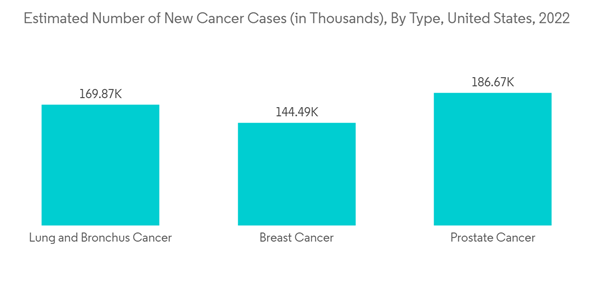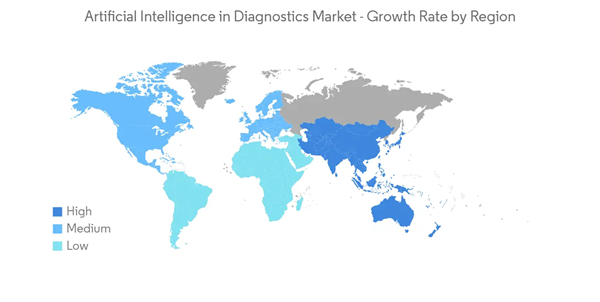The COVID-19 pandemic has significantly impacted the healthcare system, particularly diagnostics. The lockdown measures worldwide decreased public mobility and impacted the diagnostic industry. Moreover, the COVID-19 pandemic not only affected the global economy but also greatly impacted the functioning of general hospital care for non-COVID-19 patients in hospitals across the globe. However, with the increasing demand for diagnostic imaging procedures globally, the demand for implementing artificial intelligence in diagnostics is also increasing. According to the article "Artificial intelligence in the diagnosis of COVID-19: challenges and perspectives," published in April 2021, at different levels of the healthcare system, including diagnosis, artificial intelligence (AI) has been implemented. Particularly during the current pandemic, AI algorithms are crucial for the quick diagnosis of COVID-19 patients.
Additionally, AI tools were employed to handle the pandemic's depth and complexity, from diagnosis to drug development, disease transmission prediction, and population monitoring and surveillance. A study titled "The Role of Artificial Intelligence in Fighting the COVID-19 Pandemic," published in the Journal of "Nature Public Health Emergency Collection" in April 2021, proposed a temporal step method, which includes presenting recent research investigations, examining how AI observes and acts on society and the healthcare system, and reporting various data types. Hence, the deployment of AI tools in diagnosing patients with SARS-CoV-2 played a substantial role throughout the pandemic phase, thereby augmenting the market growth.
Furthermore, factors such as increasing demand for AI tools in the medical imaging field and rising focus on reducing the workload of radiologists, government initiatives to increase the adoption of AI-based technologies, and growth in funding for AI-based start-ups are anticipated to bolster the growth of the market shortly.
Incorporating artificial intelligence into imaging devices may improve the diagnosis, which is expected to aid the overall market growth during the forecast period. For instance, the Journal of the American Medical Association article titled "An Artificial Intelligence-Based Chest X-ray Model on Human Nodule Detection Accuracy from a Multicenter Study," published in December 2021, reported that an artificial intelligence algorithm was associated with improved detection of pulmonary nodules on chest radiographs compared with unaided interpretation for different levels of detection difficulty and readers with different experience. The research articles stated that artificial intelligence could be a promising technology for medical imaging shortly.
Moreover, factors such as increasing funding for AI start-ups globally are increasing the demand for increasing incorporation of AI in the diagnostic imaging modalities. For instance, in March 2022, Qure.ai (Qure), a health-tech business raising USD 40 million in fundraising, employs artificial intelligence (AI) for medical imaging diagnostics. The company further declared that it would utilize the funding to broaden and improve its global presence, particularly in the United States and Europe, and accelerate the development of products for critical care and community diagnostics. Therefore, such fundraising is anticipated to contribute to market growth.
Thus, owing to the aforementioned factors, the market studied is anticipated to grow over the analysis period. However, the lack of a skilled AI workforce and ambiguous regulatory guidelines for medical software is expected to restrain the market's growth.
AI in Diagnostics Market Trends
X-rays Segment is Expected to Dominate the Market
The X-rays segment is expected to garner a significant market share during the forecast period. Since X-rays are the most common imaging test performed in most radiology departments, the potential for artificial intelligence (AI) to aid with the triage and interpretation of traditional radiographs (X-ray images) is particularly significant. Incorporating AI in X-rays enhances its efficiency, accuracy, ease of access, and workflow, reducing time and increasing quality and patient safety. These advantages are expected to increase the demand for AI in X-rays, boosting the segment's growth during the forecast period.Additionally, the article titled "These Algorithms Look at X-Rays-and Somehow Detect Your Race," published in August 2021, stated that recently market players are heavily spending on innovations to create artificial intelligence software that interprets x-rays and for identifying conditions that doctors occasionally check, such as in the case of lung tumors. Additionally, as mentioned above, these algorithms can detect several data points on these scans that clinicians don't look for. Such developments and the growing incorporation of AI in X-rays are anticipated to drive segment growth.
Furthermore, the increase in product launches by the industry players is anticipated to drive the segment's growth. For instance, in August 2021, CXR-AID, a chest X-ray program powered by artificial intelligence (AI) developed by Fujifilm, will be made available in Japan after receiving certification from the Pharmaceuticals and Medical Devices Agency (PMDA). CXR-AID, which was created utilizing Lunit's AI technology, can recognize significant abnormal findings from X-ray images, such as chest nodules, consolidation, and pneumothorax.
Thus, owing to the abovementioned factors, the segment is expected to grow over the analysis period.
North America Dominates the Market and Expected to do Same in the Forecast Period
The use of artificial intelligence in the diagnostics market in North America is being driven by the increasing use of advanced technology in healthcare systems and the rising burden of chronic diseases in the country.For instance, according to Cancer Facts and Figures 2022 published in January 2022 by the American Cancer Society, an estimated 1.9 million new cancer cases will be diagnosed in 2022, among which prostate cancer is estimated to be 186,670, followed by 169,870 cases of lung cancer, and 144,490 cases of female breast cancer. The increased prevalence of cancer and the high burden of other chronic diseases increase the demand for accurate diagnosis and treatment. This is likely to increase the adoption of AI for early diagnosis purposes, ultimately boosting the market growth.
Furthermore, according to statistics published by the Government of Canada and released in November 2021, about 229,200 Canadians were diagnosed with cancer in 2021, and prostate cancer is expected to remain the most diagnosed cancer, accounting for 46% of all cancer diagnoses in 2021. According to the same source, breast cancer affects one out of every eight women at some point in their lives. Thus, as the number of cancer cases rises, so does the demand for early diagnosis, driving demand for AI in diagnostics over the projection period.
Several market players are engaged in implementing strategic initiatives, contributing to the market's growth. For instance, in December 2021, Roche introduced three artificial intelligence (AI)-based, deep learning image analysis Research Use Only (RUO) algorithms developed for breast cancer. In addition, in April 2022, Arterys, the vendor-neutral AI platform, launched several new modules to its robust Cardio AI clinical application and an additional (eighth) Food and Drug Administration (FDA) AI clearance based on deep learning.
Therefore, the factors mentioned earlier will likely contribute to market growth over the forecast period in the North American region.
AI in Diagnostics Industry Overview
The Artificial Intelligence in Diagnostics Market is moderately competitive and consists of several major players. Some of the companies which are currently dominating the market are Siemens Healthineers, Nanox Imaging LTD (Zebra Medical Vision, Inc.), Riverain Technologies, Vuno, Inc., Aidoc, Neural Analytics, Imagen Technologies, Digital Diagnostics, Inc., GE Healthcare, AliveCor Inc., Enlitic, and InformAI.Additional Benefits:
- The market estimate (ME) sheet in Excel format
- 3 months of analyst support
This product will be delivered within 2 business days.
Table of Contents
Companies Mentioned (Partial List)
A selection of companies mentioned in this report includes, but is not limited to:
- Siemens Healthineers
- Nanox Imaging LTD (Zebra Medical Vision, Inc.)
- Riverain Technologies
- Vuno, Inc.
- Aidoc
- Neural Analytics
- Imagen Technologies
- Digital Diagnostics, Inc.
- GE Healthcare
- AliveCor Inc.
- Enlitic
- InformAI










